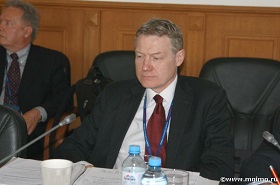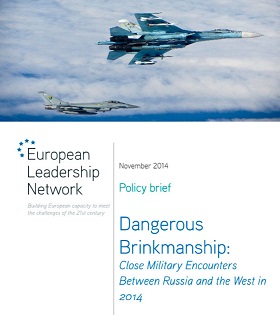Recently the European Leadership Network issued an intriguing report analyzing military encounters between Russian and West in 2014 after the onset of the Ukrainian crisis. The RIAC team asked Dr. Ian Kearns, ELN Director, to shed some light on the methodology and tools used to create the report. Some questions on the period of the Cold War and the future of Russian-Western military coexistence also arose.
Recently the European Leadership Network issued an intriguing report analyzing military encounters between Russian and West in 2014 after the onset of the Ukrainian crisis. The RIAC team asked Dr. Ian Kearns, ELN Director, to shed some light on the methodology and tools used to create the report. Some questions on the period of the Cold War and the future of Russian-Western military coexistence also arose.
The first question is about the methodology of your research. What were your principles for monitoring, gathering and processing the data?
We based the report on open sources. So we were drawing initially on the range of media reports and isolated incidents and then further research into those based on open sources. Then obviously there were some issues and areas that were then confirmed by other sources. For example, in the case of the SAS airliner incident which the report describes as an air collision with the Danish airliner 1320 – this information was subsequently confirmed by the airline itself. That was just the basic principle.
We were motivated to do the research because we were observing some isolated reports on Russian military activity in the air space over Europe. However, we knew there had been no systematic attempt to pull together an account of what was going on over time with the view to just assessing its scale and thinking about the times of activity and what kind of concerns that were being raised. So that was the original motivation - simply to try to pull together an overview of what had been happening. I think it stands to say that we were a little bit surprised ourselves by the extent of the activity and the nature of some of the incidents reported.
If we compare these incidents with the ones of the period of Cold War, when there were many similar incidents of similar kind, do you think there are fundamental differences? How does the current situation differ from what we saw 25 years ago?
I would say that it is not on the same scale as during that period. To be honest, I think that possibly from our historical vantage point the more interesting question is not so much how we can compare it with the Cold War but how the way our relations have developed since the Cold War. It seems clear that there has been a major ramping up of the level of Russian military activity in 2014 compared to 2013. Certainly that spur has been reported first by individual national governments and also by NATO in terms of scrambling aircraft and the level of activity that has been observed. If you go further back before 2013, then obviously there was a period when there was no activity of that kind.
I think one of the important distinctions to make is how much of routine is there, which NATO pilots and others would engage in as daily exercises. Then we will be able to determine if there are illegal infringements, for example in airspace – an apparent simulation of an attack. I mean the extent to which there is any evidence that NATO Is doing the same thing to Russia. I mean if somebody in Russia wanted to put together a good analysis of what they think is a comparable survey - that would be quite interesting. Our observation at this point is that we are not seeing large descriptions in Russian media of NATO incursions into Russian airspace and waters. I mean we have an account in the report of the American submarine incident but that seems to us to be the important issue. These are exactly the benchmarks that we develop in our report that show the difference between the Cold War era and nowadays. You see from the analysis in our report we think some of that is different and is a bit more assertive and cause for concern.
Another question is about the possible impact of this problem. How would you assess the probability that these tensions might cause greater military tension?
I think the major danger is an unintended incident which triggers a potential dynamic of escalation. Another thing that seems clear to us is that the activity going on seems to be sanctioned from the centre. There seems to be a general policy decision taken that the Russian military should be a bit more active, assertive and visible to everybody else. One could debate the reasons for that and its legitimacy. Nonetheless the evidence seems to suggest that it is part of a systematic general change of stance. The implementation of that comes down to individual commanders and pilots, who are becoming a little bit more assertive, expecting to come closer to NATO forces and warships and test their reaction. For example, the Black Sea incident that we describe where the Canadian ship locks radar on an approaching Russian aircraft, there is an issue for the pilot – what should a pilot do? It is not a particularly comfortable feeling for a pilot to know that radar has been locked on an aircraft. You are then asking individual personnel to decide “What should I do in the situation I am currently in?” It only takes one or two bad decisions at that level that can possibly become an incident that involves genuine shooting, casualties and then you are in a dynamic in which one side is blaming the other and national prestige is at stake.
One of the common themes in international crises is that sometimes events grow of control, begin to drive the future state of the crisis and drive policy rather than the policymakers in control of events. So we think that is the danger, because the danger of the dynamic is that one incident can lead to another even if no side intends it. The risks of that have just increased. There was other one incident with an SAS airliner which we quite explicitly described had the two planes collided. We think that it would be politically impossible for Western leaders to do anything other than say to the Russian leadership, “If you are going to fly your warplanes with transponders switched off in airspace where civilian commercial airliners are flying, then we will need to interdict them forcefully and pre-emptively”. You can imagine the dynamic if you know that 132 people on that plane had died, it would not really have been feasible for leaders to say, “We are going to keep aircraft up in the skies preventively and not do anything about the fact that there are military aircrafts flying around with transponders switched off”. This is just another example of a case which could have had an escalatory dynamic even though nobody intended it. That is our concern.
Interviewed by RIAC Program Director of Ivan Timofeev and RIAC manager Natalia Evtikhevich.





